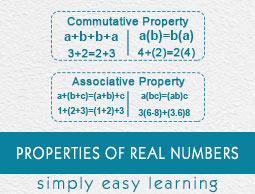
- Properties of Real Numbers
- Home
- Identifying Like Terms
- Combining like terms: Whole number coefficients
- Introduction to properties of addition
- Multiplying a constant and a linear monomial
- Distributive property: Whole Number coefficients
- Factoring a linear binomial
- Identifying parts in an algebraic expression
- Identifying equivalent algebraic expressions
- Introduction to properties of multiplication
Identifying equivalent algebraic expressions
Definition
Equivalent algebraic expressions are those expressions which on simplification give the same resulting expression.
Two algebraic expressions are said to be equivalent if their values obtained by substituting the values of the variables are same.
To represent equivalent expressions an equality (=) sign is used.
Examples of Equivalent Expressions
3(x + 2) and 3x + 6 are equivalent expressions because the value of both the expressions remains the same for any value of x.
For instance, for x = 4,
3(x + 2) = 3(4 + 2) = 18 and
3x + 6 = 3 × 4 + 6 = 18.
The expressions 6(x2 + 2y + 1) and 6x2 + 12y + 6 are equivalent expressions
and can also be written as 6(x2 + 2y + 1) = 6x2 + 12y + 6.
In this lesson, we learn to identify equivalent expressions.
Given an expression, we select all equivalent expressions from a list.
Example 1
For given expression, select one correct equivalent expression from the four options.
8y + 4y + 2y
A - 11y
B - y + 13
C - 7y - 6y
D - 9y + 5y
Solution
Step 1:
As 9y + 5y = 14y = 8y + 4y + 2y, the given expression
Step 2:
Only option D is the correct equivalent expression
Example 2
For given expression, select one correct equivalent expression from the four options.
20x 10y
A - 5(4x - 2y)
B - 10x + 25y
C - 5(5x + 2y)
D - 5(5x - 10y)
Solution
Step 1:
As 5(4x 2y) = 20x 10y, the given expression
Step 2:
Only option A is the correct equivalent expression
Example 3
For given expression, select one correct equivalent expression from the four options.
15x + 25x2
A - 7(5x2 + 2x)
B - 15x 35x2
C - 5x(3 + 5x)
D - 5(3 + 7x)
Solution
Step 1:
As 5x (3 + 5x) = 15x + 25x2, the given expression
Step 2:
Only option C is the correct equivalent expression